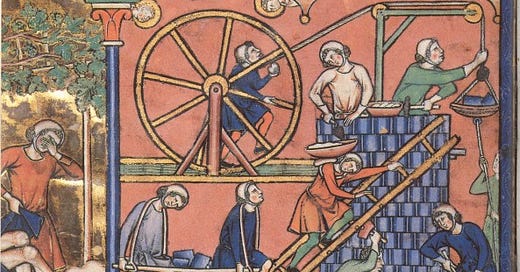Gothic technological revolution
Review of Medieval Technology and Social Change by Lynn Townsend White Jr.
This is a dense, brief history on how technological change impacted late medieval society. The historical backdrop to the technological revolution takes place from the beginning of the Gothic era, when the Dark Ages had given way to a period of rapid change (1150-1375). This is when stable cities began to flourish in relatively greater safety, vast ranges of forest were cleared in a kind of internal colonization for purposes of farming, and, allied to the castle fortresses that were springing up, a knightly culture was born with new norms and modes of warfare.
It was a time of economic growth and massive population expansion, exemplified by the remarkable Cathedrals that were built - communal projects that could take centuries to complete. This book is not about the Cathedrals, but mundane-seeming technologies. White argues that three fundamental inventions spread at this time.
First, there was the stirrup. This simple device enabled riders to better balance themselves, completely changing what they could do while mounted on their horses. As such, they were able to use heavier weapons, like sabers and battering rams for striking without fearing they would lose their balance or get knocked off by the force of the blow. Because the technology was very expensive, it offered further advantage to the aristocratic knights, reinforcing their mastery over peasants. In addition to the unifying force of a rejuvenated and more uniform Christian ideology, their military prowess formed the basis of knightly culture.
Second, there was a revolution in agricultural techniques, that hugely improved upon the man-driven deforestation that was taking place at the time. This is very technical stuff about how plows were altered so that they turned over the earth in new ways, how new plow-horse harnesses were braced on their shoulders rather dependent on a neck-chocking collar. All of this enhanced productivity, fueling the urban boom underway.
Finally, White examines the sudden fascination with mechanical devices, in particular the crank. This section was, in my opinion, the least developed and its results the most ambiguous. There were new, more complex devices made, much of it related to the search for a perpetual motion machine. This led to experimentation and the creation later of more sophisticated lever and locomotive devices. It is like the mechanical equivalent to alchemy and its relation to chemistry.
This is a valuable addition to medieval studies and technological history. I found it thoroughly enriching, an excellent overview of a period I knew from a different angle, and a quick read.



